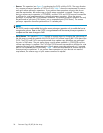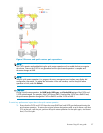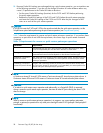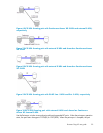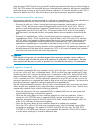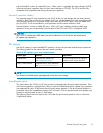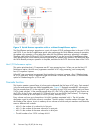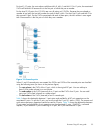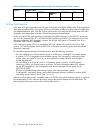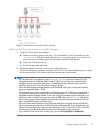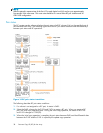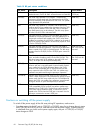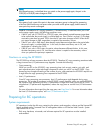
NOTE:
• Combining L1 and L2 pairs with Continuous Access XP volumes is allowed; however, Continuous
AccessXPconsidersnodeandleafvolumesassecondaryvolumes(S-VOLs).
• When a P-VOL is paired with more than one S-VOL, the disk array assumes there are the same
numberofvirtualP-VOLs.Forexample,whenaP-VOLispairedwiththreeS-VOLs,thereisonly
onerealP-VOL,butthediskarrayassumestherearethreevirtualP-VOLs. AVirtualP-VOLis
called an MU (Mirror Unit).
• “MU#” in Figure 12 means MU number, which identifies each MU. MU#=1 under S-VOL1 means
the MU number of the P-VOL that is paired with the S-VOL1 is 1.
Table 9 Relationship between L1 pair status and L2 pair operations
L2 Pair Operations
L1 Pair
Status
Paircreate
Pairsplit
Pairresync
Reverse/
Quick
Restore
Pairsplit-E Pairsplit-S
COPY(PD) OK
NO
(CMD RJT)
OK
NO
(CMD RJT)
OK OK
PAIR
OK
NO
(CMD RJT)
OK
NO
(CMD RJT)
OK OK
COPY(SP) OK
NO
(CMD RJT)
OK
NO
(CMD RJT)
OK OK
PSUS(SP) OK
NO
(CMD RJT)
OK
NO
(CMD RJT)
OK OK
PSUS OK OK OK
NO
(CMD RJT)
OK OK
COPY(RS) OK
NO
(CMD RJT)
OK
NO
(CMD RJT)
OK OK
COPY(RS-R) OK
NO
(CMD RJT)
OK
NO
(CMD RJT)
OK OK
PSUE OK
NO
(CMD RJT)
OK
NO
(CMD RJT)
OK OK
Table 10 shows the relationship between the L2 pair status and availability of pair operations on the
associated L1 pairs. (CMD RJT = command rejected.) If you delete an L1 pair containing an L2 pair, the
L2 pair becomes the L1 pair.
34
Business Copy XP (BC) for the Array



